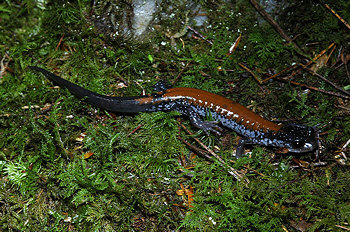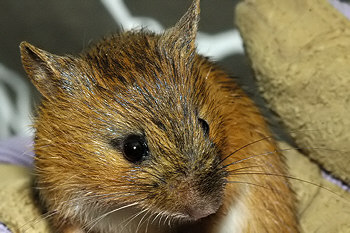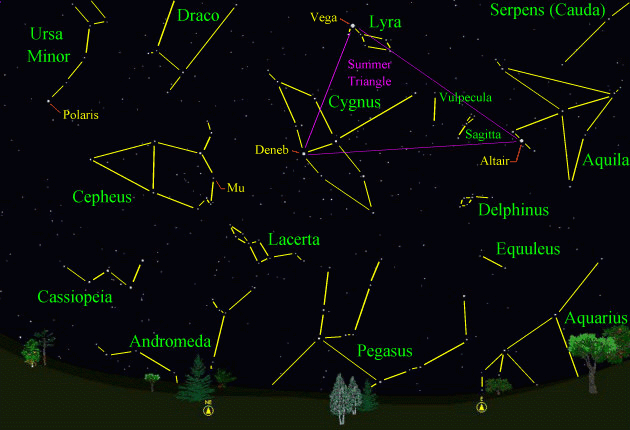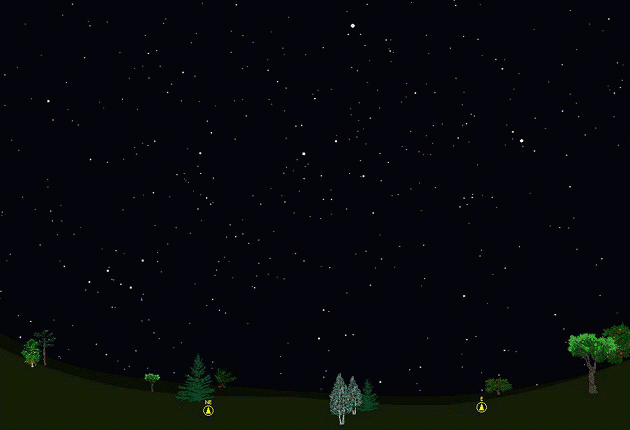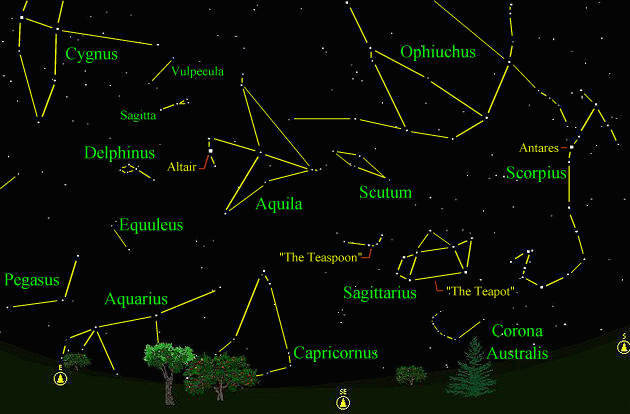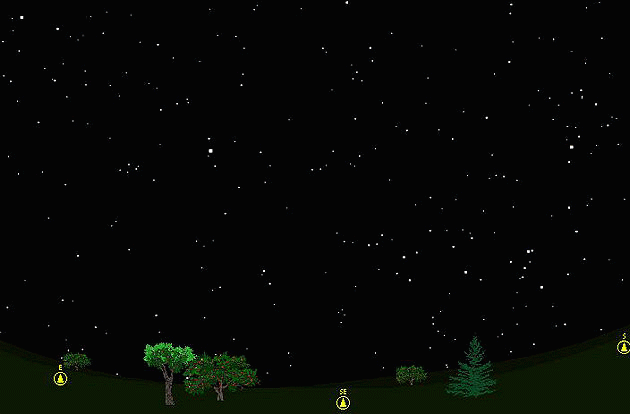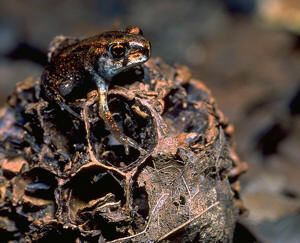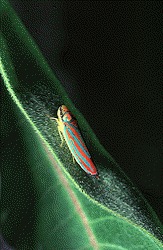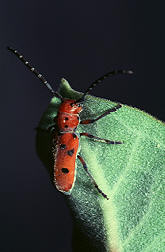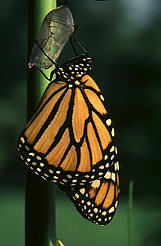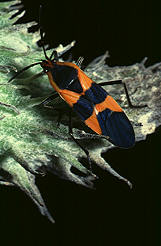The purpose of this feature is to give scout leaders, educators and naturalists an idea of some of the natural events coming up each month. We will try to cover a variety of natural events ranging from sky events to calling periods of amphibians, bird and mammal watching tips, prominent wildflowers and anything else that comes to mind. We will also note prominent constellations appearing over the eastern horizon at mid-evening each month for our area for those who would like to learn the constellations. If you have suggestions for other types of natural information you would like to see added to this calendar, let us know! Note: You can click on the hyperlinks to learn more about some of the featured items. To return to the Calendar, hit the "back" button on your browser, NOT the "back" button on the web page. All charts are available in a "printer friendly" mode, with black stars on a white background. Left clicking on each chart will take you to a printable black and white image. Notes and Images From June 2005
June took us to Unicoi county to Rocky Fork Wildlife Management Area. We camped for three days in this beautiful and rugged wilderness area as part of a wildlife survey conducted by the Tennessee Wildlife Resources Agency. Andrea found this Yonahlossee Salamander on a rock face on June 21st. This beautiful salamander is rare in Tennessee, and is found only in Unicoi, Carter and Johnson counties in Tennessee. This find extends the range of this salamander south of the Nolichucky River in Unicoi county. The total worldwide range of this salamander is just a few counties in the mountains of Tennessee and North Carolina.
This beautiful creature is a Woodland Jumping Mouse. The range of this northern mouse in Tennessee is limited to a narrow strip in the Appalachian Mountains of east Tennessee. It uses its long, white-tipped tail to keep its balance as it hops along on its large hind feet. When frightened it drums its tail on the ground. It is a good swimmer and a amazing jumper, able to take great leaps of six through eight feet. Its diet consists of ground fungi, seeds, caterpillars, beetle larvae and berries. According to Barbour, "the seeds of Jewelweed, or Wild Touch-Me-Not, are especially important." In October or November, jumping mice increase their body weight as much as 30 percent and retreat to a nest of dry leaves, usually in a burrow but sometimes in a natural cavity beneath a rock or a log. There below the frost line they hibernate through the winter until April, when they become active again.
Sky Events for July 2005: Evening Sky: Venus and Mercury continue to be close together during the first few days of July, and you can use bright Venus to guide you to the fainter planet. They will both fit easily in one binocular field. Look 30 to 45 minutes after sunset low in the western sky. On July 2nd, Mercury is about 1 degree to the left of Venus. Jupiter continues to dominate the evening sky, slowly making its way through Virgo. Steady your binoculars against a tree and see if you can spot one or more of the four bright moons that Galileo discovered in 1610. Morning Sky: Mars is rapidly brightening in the eastern sky, glowing like a hot coal as it rises around 12:25am CDT at mid-month. The Delta Aquarid meteor shower peaks on in the early morning hours of July28th, but observations will be hampered the brightness of the third-quarter moon. All times noted in the Sky Events are for Franklin, Tennessee and are Central Daylight Time. These times should be pretty close anywhere in the mid-state area. Constellations: The views below show the sky looking east at 9:50pm CDT on July
15th. The first view shows the sky with the constellation outlined and
names depicted. Star and planet names are in yellow. Constellation
names are in green. The second view shows the same scene without
labels. Looking to the east, see if you can spot the constellations of Cygnus,
the Swan, Lyra, the Lyre and Aquila, the Eagle. The bright stars Deneb,
Altair and Vega form the "Summer Triangle."
If you locate them first, you will have an easier time finding the
constellations around them. Below and to the left of Altair is the
constellation of Delphinus, the Dolphin, looking like it's leaping over the
faint stars of Equuleus, the Foal.
Above Delphinus look for the arrow-like form of Sagitta, the
Arrow. Between Sagitta and Cygnus lie the faint stars of Vulpecula,
the Fox. Looking northeast, see if you can pick out Cepheus, the
King. Mu Cephei, nicknamed the “Garnet
Star” by William Herschel, is a beautiful deep red star in binoculars or a
small telescope. Below and to the right
of Cepheus look for the faint stars that make up Lacerta, the
Lizard. Below and to the left of Cepheus, look
for Cassiopeia. Looking to the southeast, the brightest stars of Sagittarius,
the Archer, form a grouping nicknamed, "The Teapot."
Look for them above the southeast horizon. On very clear summer nights,
the bright portions of the Milky Way above Sagittarius look like steam
rising from the spout of the teapot. If you look just to the right of the
spout of the teapot, you will be looking in the direction of the center of our
galaxy. The little grouping of stars to the left of Sagittarius is
nicknamed, "The Teaspoon." Below The Teapot, look for Corona Australis, the
Southern Crown. All of the constellation Scorpius,
the Scorpion, with its bright star Antares, should now be above the
horizon in the southeast. Also in the
southeast and above Sagittarius, look for the faint stars of Scutum.
On Learning the Constellations: We advise learning a few constellations each month, and then following them through the seasons. Once you associate a particular constellation coming over the eastern horizon at a certain time of year, you may start thinking about it like an old friend, looking forward to its arrival each season. The stars in the evening scene above, for instance, will always be in the same place relative to the horizon at the same time and date each July. Of course, the planets do move slowly through the constellations, but with practice you will learn to identify them from their appearance. In particular, learn the brightest stars (like Altair and Vega in the above scene looking east), for they will guide you to the fainter stars. Once you can locate the more prominent constellations, you can "branch out" to other constellations around them. It may take you a little while to get a sense of scale, to translate what you see on the computer screen or what you see on the page of a book to what you see in the sky. Look for patterns, like the stars that make up the constellation Lyra. The earth's rotation causes the constellations to appear to move across the sky just as the sun and the moon appear to do. If you go outside earlier than the time shown on the charts, the constellations will be lower to the eastern horizon. If you observe later, they will have climbed higher. As each season progresses, the earth's motion around the sun causes the constellations to appear a little farther towards the west each night for any given time of night. If you want to see where the constellations in the above figures will be on August 15th at 9:50pm CDT, you can stay up till 11:50pm CDT on July 15th and get a preview. The westward motion of the constellations is equivalent to two hours per month. A good book to learn the constellations is H. A. Rey's classic, The Stars, A New Way to See Them. Rey's depictions of the constellations and witty commentary are terrific. A good general reference book on astronomy is the Peterson Field Guide, A Field Guide to the Stars and Planets, by Pasachoff. The book retails for around $14.00. My favorite books about astronomers are Richard Preston's First Light, and the wonderful Starlight Nights, by Leslie Peltier. A good beginners software program for learning the night sky is the Starry Night Beginner program. Visit the Starry Night web site at www.starrynight.com The program retails for around $30.00 and contains a wealth of information.
Amphibians:
July’s frogs and toads are much like June’s. Listen for Cope's Gray Treefrogs, Gray Treefrogs, Bird-Voiced Treefrogs, Green Treefrogs and Barking Treefrogs. Northern Cricket Frogs and Southern Cricket Frogs call a lot during July, and the calls of Bullfrogs and Green Frogs fill the night air. After heavy rains listen for the high, insect-like call of the Eastern Narrowmouth Toad and the strange-sounding Eastern Spadefoot. Be sure to look closely at young toads you encounter. Sometimes we find young Eastern Spadefoots foraging during the day. A young Eastern Spadefoot will have vertical pupils, a tiny spade on its rear feet and will often have some red warts, even when only a fraction of an inch long. A hand lens helps to see these features (or turn your binoculars around and use them for a magnifying glass.)
Insects: By the end of June and the beginning of July, many of the players
in the summer insect orchestras have started performing. Cicadas are calling now during the day and
at dusk, and True Katydids evoke memories of past summer evenings with their familiar
song. Fork-tailed Bush Katydids give their short upward-slurred rasps. Coneheads play their far-ranging,
long monotone rasps, the pitch Doppler-shifting
downward as you drive by them in the dark, and fireflies mirror the stars
overhead with their gentle light. By day, some of the more colorful insects can
be found in patches of milkweed.
Monarch butterflies lay their tiny cream-colored
eggs on the milkweed leaves
and you can usually find a Monarch caterpillar munching on the foliage. If you’re lucky, you might even find the
beautiful, jewel-like chrysalis of the Monarch nearby. To see a Monarch caterpillar form it's chrysalis,
click
here. Scarlet and Green Leafhoppers, Large
Milkweed Bugs and Red Milkweed Beetles all add their brilliant warning colors
to the scene.
To
learn more about insect songs we recommend: Songs of Crickets and Katydids of the Mid-Atlantic States, by Rannels, Hershberger and Dillon
Archives (Remember to use the back button on your browser, NOT the back button on the web page!)
Natural Calendar
February 2005
Natural Calendar
December 2004
Natural Calendar
November 2004
Natural Calendar
September 2004
Natural Calendar
February 2004
Natural Calendar
December 2003
Natural Calendar
November 2003
Natural Calendar
September 2003 Natural Calendar February 2003 Natural Calendar December 2002 Natural Calendar November 2002 Nature Notes Archives: Nature Notes was a page we published in 2001 and 2002 containing our observations about everything from the northern lights display of November 2001 to frog and salamander egg masses. Night scenes prepared with Starry Night Pro software All images and recordings © 2005 Leaps
|
